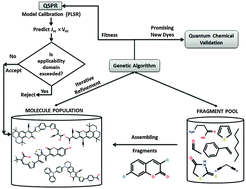Artificial evolution of coumarin dyes for dye sensitized solar cells†
Abstract
The design and discovery of novel molecular structures with optimal properties has been an ongoing effort for materials scientists. This field has in general been dominated by experiment driven trial-and-error approaches that are often expensive and time-consuming. Here, we investigate if a de novo computational design methodology can be applied to the design of coumarin-based dye sensitizers with improved properties for use in Grätzel solar cells. To address the issue of synthetic accessibility of the designed compounds, a fragment-based assembly is employed, wherein the combination of chemical motifs (derived from the existing databases of structures) is carried out with respect to user-adaptable set of rules. Rather than using computationally intensive density functional theory (DFT)/ab initio methods to screen candidate dyes, we employ quantitative structure–property relationship (QSPR) models (calibrated from empirical data) for rapid estimation of the property of interest, which in this case is the product of short circuit current (Jsc) and open circuit voltage (Voc). Since QSPR models have limited validity, pre-determined applicability domain criteria are used to prevent unacceptable extrapolation. DFT analysis of the top-ranked structures provides supporting evidence of their potential for dye sensitized solar cell applications.


 Please wait while we load your content...
Please wait while we load your content...